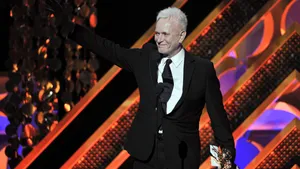The recently-released Blade Runner: Origins Vol. 1 is far more than a simple prequel to the nearly 40-year-old Ridley Scott film starring Harrison Ford and Sean Young. As the only sanctioned comic book told within the Blade Runner universe, Blade Runner: Origins Vol. 1 is a gripping science fiction story that also smartly and thoughtfully explores a character's trans identity. Writers K. Perkins, Mellow Brown and Mike Johnson mix elements of noir, cyberpunk, and detective mystery and mix-in plenty of queer and trans themes.
For the uninitiated, the original and classic Blade Runner movie (and the 2017 follow-up Blade Runner 2049 starring Ryan Gosling) centers around bioengineered human-like beings called Replicants. Created by the insidious Tyrell Corporation to serve mankind, the Replicants become murderous as they rebel against their programming. It then falls on the Blade Runners, legally authorized hunters called upon to track down rogue Replicants, to terminate them.
"Blade Runner was one of my first forays into not only sci-fi but noir," author K. Perkens tells The Advocate. "I remember watching it as a teenager and my mind exploding: this film mixed genres and created this hyper-futuristic world that dealt with time-worn themes from our own past."
Co-writer Brown agrees that Blade Runner is a seminal work of science fiction for any fan of the sci-fi genre, adding that "being a writer in science fiction, Blade Runner is inescapable. Particularly as a conversation about the exploration of identity via noir."
Both writers were keen to add BIPOC (Black, Indigenous, People of Color) voices as well an LGBTQ+ presence to Blade Runner: Origins Vol. 1. The book is set 10 years before the events depicted in the first movie. It focuses on LAPD detective Cal Moreau, who's best friend just happens to be a drag queen, as he investigates the possible suicide of one of the scientists working at the Tyrell Corporation. From that premise the story's many twists and turns reveal a key female character has transferred her "being" into a brand new male Replicant.
Perkins and Brown felt it important to explore the various corners of the Blade Runner universe by delving into trans representation. "Gender and trans visibility are really important to me," writer K.. Perkins says. "As someone who is still exploring their own identity in these ways, I wanted our character's quest for identity to be context for their greater story, not the focus of it."
Brown was all too happy to explore a queer and BIPOC narrative. "I think seeing this inclusiveness behind the camera and pen is the most impactful part of this, because they capture the nuances of these lifestyles and show how it not only pushes the story forward, but enriches it."
With wonderfully moody and expressive artwork by Fernando Dagnino, a stunning illustrator who has worked for Marvel, DC, and IDW comics, Blade Runner: Origins Vol. 1 hits all the right notes without being preachy, overly sentimental, and never sacrifices the futuristic expansiveness of the Blade Runner series.
As to why a genre-bending science fiction movie from the early 1980s still resonates today, Perkins says that the Blade Runner series "is a perfect example of how we can examine ourselves and our society through the detachment of genre storytelling. We can interrogate, reflect on, and process things that are affecting us through these fictional worlds -- there's safety in that."
Blade Runner: Origins Vol. 1 is available now.




































































Charlie Kirk DID say stoning gay people was the 'perfect law' — and these other heinous quotes